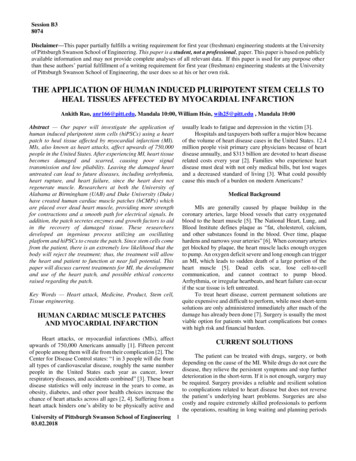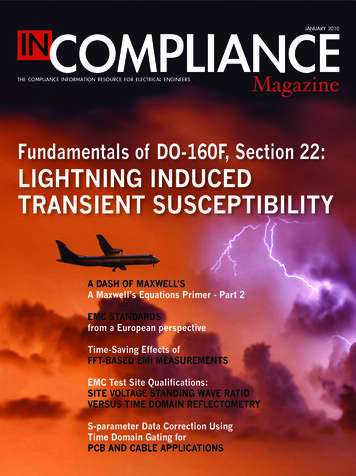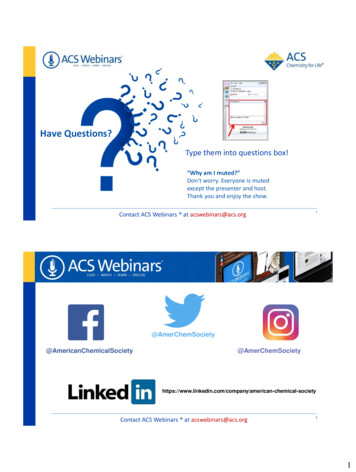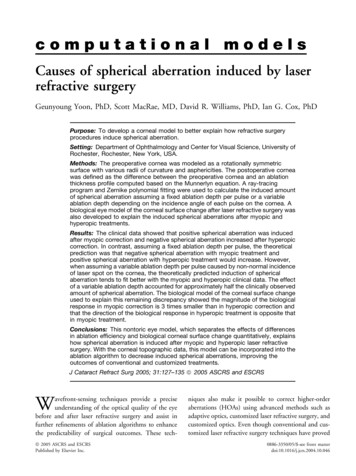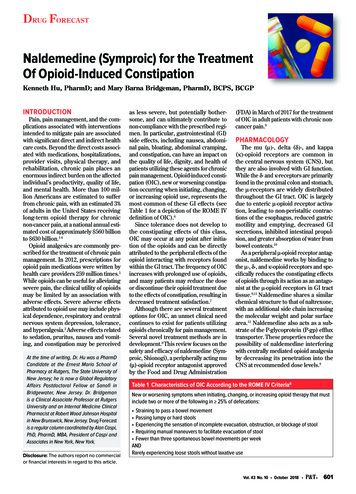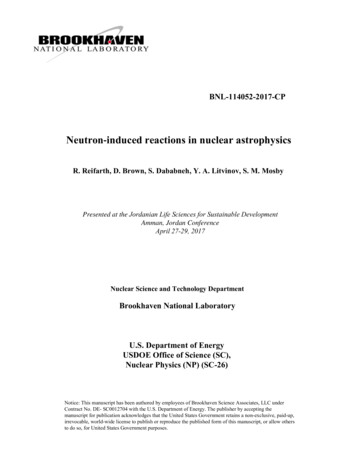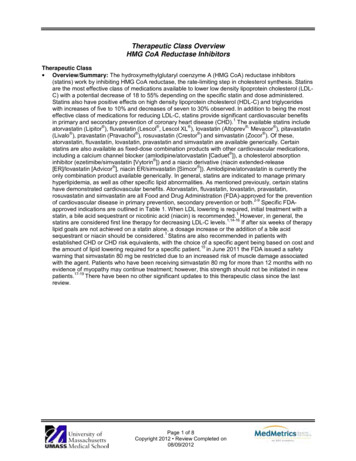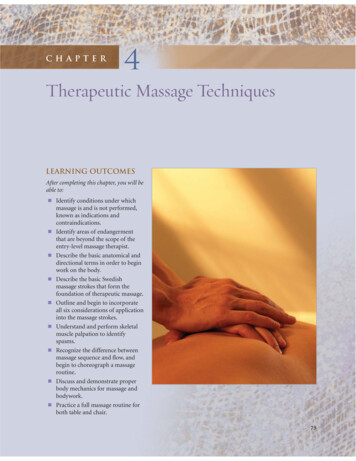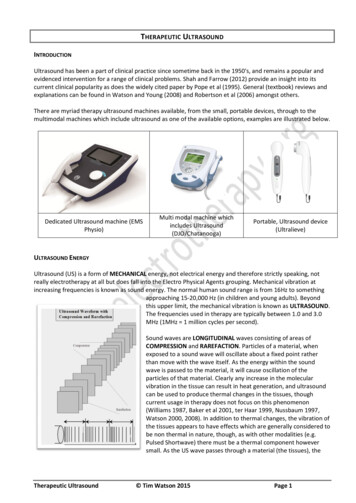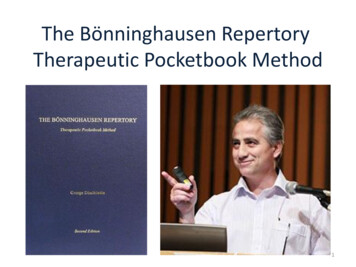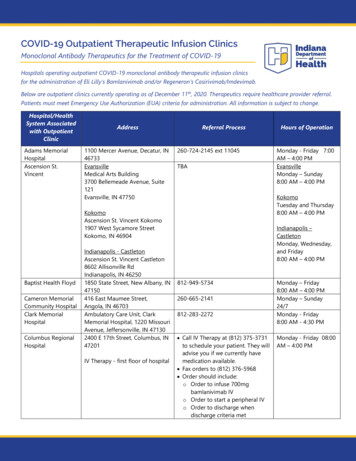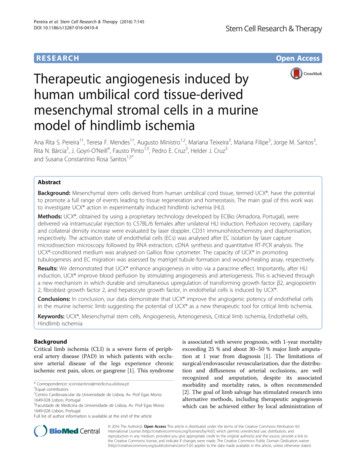
Transcription
Pereira et al. Stem Cell Research & Therapy (2016) 7:145DOI 10.1186/s13287-016-0410-4RESEARCHOpen AccessTherapeutic angiogenesis induced byhuman umbilical cord tissue-derivedmesenchymal stromal cells in a murinemodel of hindlimb ischemiaAna Rita S. Pereira1†, Teresa F. Mendes1†, Augusto Ministro1,2, Mariana Teixeira3, Mariana Filipe3, Jorge M. Santos3,Rita N. Bárcia3, J. Goyri-O’Neill4, Fausto Pinto1,5, Pedro E. Cruz3, Helder J. Cruz3and Susana Constantino Rosa Santos1,5*AbstractBackground: Mesenchymal stem cells derived from human umbilical cord tissue, termed UCX , have the potentialto promote a full range of events leading to tissue regeneration and homeostasis. The main goal of this work wasto investigate UCX action in experimentally induced hindlimb ischemia (HLI).Methods: UCX , obtained by using a proprietary technology developed by ECBio (Amadora, Portugal), weredelivered via intramuscular injection to C57BL/6 females after unilateral HLI induction. Perfusion recovery, capillaryand collateral density increase were evaluated by laser doppler, CD31 immunohistochemistry and diaphonisation,respectively. The activation state of endothelial cells (ECs) was analysed after EC isolation by laser capturemicrodissection microscopy followed by RNA extraction, cDNA synthesis and quantitative RT-PCR analysis. TheUCX -conditioned medium was analysed on Gallios flow cytometer. The capacity of UCX in promotingtubulogenesis and EC migration was assessed by matrigel tubule formation and wound-healing assay, respectively.Results: We demonstrated that UCX enhance angiogenesis in vitro via a paracrine effect. Importantly, after HLIinduction, UCX improve blood perfusion by stimulating angiogenesis and arteriogenesis. This is achieved througha new mechanism in which durable and simultaneous upregulation of transforming growth factor β2, angiopoietin2, fibroblast growth factor 2, and hepatocyte growth factor, in endothelial cells is induced by UCX .Conclusions: In conclusion, our data demonstrate that UCX improve the angiogenic potency of endothelial cellsin the murine ischemic limb suggesting the potential of UCX as a new therapeutic tool for critical limb ischemia.Keywords: UCX , Mesenchymal stem cells, Angiogenesis, Arteriogenesis, Critical limb ischemia, Endothelial cells,Hindlimb ischemiaBackgroundCritical limb ischemia (CLI) is a severe form of peripheral artery disease (PAD) in which patients with occlusive arterial disease of the legs experience chronicischemic rest pain, ulcer, or gangrene [1]. This syndrome* Correspondence: sconstantino@medicina.ulisboa.pt†Equal contributors1Centro Cardiovascular da Universidade de Lisboa, Av. Prof Egas Moniz1649-028 Lisbon, Portugal5Faculdade de Medicina da Universidade de Lisboa, Av. Prof Egas Moniz1649-028 Lisbon, PortugalFull list of author information is available at the end of the articleis associated with severe prognosis, with 1-year mortalityexceeding 25 % and about 30–50 % major limb amputation at 1 year from diagnosis [1]. The limitations ofsurgical/endovascular revascularization, due the distribution and diffuseness of arterial occlusions, are wellrecognized and amputation, despite its associatedmorbidity and mortality rates, is often recommended[2]. The goal of limb salvage has stimulated research intoalternative methods, including therapeutic angiogenesiswhich can be achieved either by local administration of 2016 The Author(s). Open Access This article is distributed under the terms of the Creative Commons Attribution 4.0International License (http://creativecommons.org/licenses/by/4.0/), which permits unrestricted use, distribution, andreproduction in any medium, provided you give appropriate credit to the original author(s) and the source, provide a link tothe Creative Commons license, and indicate if changes were made. The Creative Commons Public Domain Dedication o/1.0/) applies to the data made available in this article, unless otherwise stated.
Pereira et al. Stem Cell Research & Therapy (2016) 7:145pro-angiogenic growth factors and gene- or cell-basedtherapies [3].Mesenchymal stem cells (MSCs) hold great promise asa therapy for PAD, mainly due to their paracrine activityand immunosuppressive capacity [4]. MSCs are knownto home specifically to hypoxic tissues following injury[5] where they potentiate vascular growth through therelease of pro-angiogenic factors [6]. It was previouslyreported that autologous, allogeneic and xenogeneicMSC administration induced therapeutic angiogenesis inanimal models of hindlimb ischemia (HLI) [7]. In ameta-analysis of cell therapy for PAD, it was found thatautologous bone marrow MSCs delivery led to improvedindices of ischemia and pain-free walking [8]. Althoughfirst harvested from the bone marrow, MSCs have sincebeen identified in many other tissues, namely adiposetissue [9] and umbilical cord tissue [10]. UCX inparticular are MSCs obtained from the human umbilicalcord Wharton’s jelly that are isolated, expanded and cryopreserved according to a patented method (PCT/IB2008/054067; WO 2009044379) and produced according toadvanced therapy medicinal product (ATMP) guidelines [11]. UCX fulfil the MSC criteria as defined bythe International Society for Cellular Therapy (ISCT)[12]. UCX cells are advantageous in comparison toother sources due to the absence of invasiveness intheir collection process, their faster self-renewal,higher cell yield and being more potent modulatorsof the immune system than bone marrow MSCs,making them more attractive for allogeneic cellulartherapies.Recently, it was demonstrated that UCX paracrineactivity represses T cell activation and promotes theexpansion of regulatory T cells (Tregs) better than bonemarrow MSCs [13]. Furthermore, by using an acutearthritis in vivo model it was found that UCX can reduce paw edema more efficiently than bone marrowMSCs. The use of a chronic arthritis model showed thatUCX induce faster remission of local and systemic arthritic manifestations [13]. The UCX tissue regenerationcapacity suggested for rheumatoid arthritis was later corroborated for myocardial infarction. By using a mousemodel of myocardial infarction, it was shown that UCX preserve cardiac function and attenuate adverse tissueremodelling after intramyocardial transplantation [14].Interestingly, it was demonstrated that this cardioprotective effect was exerted through paracrine mechanismsinvolving angiogenesis promotion [14]. Furthermore, invitro studies, performed with conditioned medium (CM)produced by UCX grown in classical two-dimensionalmonolayer cultures, have demonstrated the potential toinduce keratinocyte migration in the early stages ofwound healing [15]. Moreover, UCX were able to attractbone marrow MSCs in vivo with potential to promotePage 2 of 12the formation of granulation tissue, contraction by myofibroblasts, angiogenesis, vasculogenesis and epithelization [15]. These results strongly suggest that UCX havethe potential to promote a full range of events leading totissue regeneration and homeostasis. Interestingly, itwas shown recently that the later proliferative and remodelling stages of wound healing promoted by theCM of the two-dimensional monolayer cultures wereimproved by using three-dimensional culture-derivedCM [16]. An enhanced secretion of healing-inducingparacrine factors by UCX including the extracellularcellular matrix metalloproteinase-2 (MMP-2) andmatrix metalloproteinase-9 (MMP-9), collagen I, fibronectin, laminin, collagen IV and angiogenic factorssuch as vascular endothelial growth factor A (VEGF-A),granulocyte-colony stimulating factor (G-CSF), transforming growth factor β1 (TGF-β1), fibroblast growth factor 2(FGF-2), hepatocyte growth factor (HGF) and interleukin6 (IL-6) was observed in the CM of three-dimensional cultures based on self-assembled spheroids [16].In this work, our data corroborate that UCX enhanceangiogenesis in vitro and in vivo, by modulating endothelial cells. In vitro, we found that UCX promotetubule formation and endothelial cell migration. Importantly, our results have demonstrated that UCX in thesetting of experimentally induced unilateral hindlimbischemia (HLI) stimulate angiogenesis and collateral vessel development and thereby improve blood perfusion inthe ischemic limb demonstrating the potential of UCX as new therapeutic tool for CLI. Furthermore, and to thebest of our knowledge, this is the first study in an experimental model of hindlimb ischemia showing that, invivo and in a sustained way human MSCs upregulate theendothelial gene expression of several pro-angiogenicplayers (such as transforming growth factor β2 (Tgfβ2),angiopoietin 2 (Ang-2), Fgf-2, Hgf ), shedding light on thepotential mechanisms of action of this particular ATMP.MethodsEthics and regulationsAll animal procedures were performed according to Directive 2010/63/EU. The procedures were approved by the institutional Animal Welfare Body and licensed by DGAV,the Portuguese competent authority for animal protection(license number 023861/2013).Cell cultureUCX were cultured in static monolayers in α-MEMwith 1 g/L glucose and 2 mM glutamine (Sigma-Aldrich,St. Louis, MO, USA), hereafter designated basal medium(BM), supplemented with 20 % foetal bovine serum(FBS; Gibco , Madrid, Spain), in a humidified incubatorat 37 C and 7 % CO2.
Pereira et al. Stem Cell Research & Therapy (2016) 7:145Human umbilical vein endothelial cells (HUVECs)(Sciencell, Carlsbad, CA, USA) were cultured in M199media (Sigma-Aldrich, St. Louis, MO, USA), hereafterdesignated endothelial basal medium (EBM) supplemented with 10 % FBS (Gibco , Thermo Fisher Scientific, Waltham, MA, USA), 50 μg/ml endothelial cellgrowth supplement (ECGS) (Sigma-Aldrich), 100 μg/mlheparin (Sigma-Aldrich) and 1 % penicillin-streptomycin(10,000 U/mL, Sigma-Aldrich), hereafter designatedendothelial growth medium (EGM). Cells were grown inflasks coated with 0.2 % gelatin (Sigma-Aldrich) until70 % confluence and used up to passage 6.Preparation of conditioned mediaUCX were seeded in BM supplemented with 5 % FBSand grown until 90 % confluence. After washing cellswith phosphate-buffered saline (PBS), BM (withoutserum) was added for 24 hours. Thereafter, BM was replaced and conditioned for 48 hours at 37 C and 7 %CO2 after which it was collected, centrifuged at 300 g for10 minutes to remove cell debris, filtered (0.22 μm poresize, Merck Millipore, Billerica, MA, USA), and concentrated using 5 kDa cut-off spin concentrators (AgilentTechnologies, Santa Clara, CA, USA) as per manufacturer’s recommendations. Control conditioned mediumsamples underwent the same procedure as describedabove, but in the absence of cells.Quantification of secreted factorsThe quantification of HGF, VEGF-A, TGF-β1, IL-8,platelet-derived growth factor-AA (PDGF-AA) andFGF-2 in the conditioned medium was performed usinga commercially available kit (FlowCytomix ; eBioscience,San Diego, CA, USA) according to the manufacturer’sinstructions. Samples were acquired on a Gallios flowcytometer (Beckman Coulter, Brea, CA, USA) and theresults obtained using FlowCytomix Pro 3.0 Software(eBioscience).Tubule formation assayThe tubule formation assay was performed using the thickgel method of preparation. Briefly, after thawing overnight, the matrigel (Corning, Corning, NY, USA) wasplated into a pre-cooled 48-well plate (Nunc , ThermoFisher Scientific) (180 μl per well) using a chilled pipet tip.After polymerization of matrigel at 37 C, 5 % CO2, for45 minutes, HUVECs were inoculated at a density of4.5 104 cells/cm2 on top of the matrigel in 350 μl ofEBM. Cells were then incubated for 1 hour at 37 C, 5 %CO2. 1 106 UCX were resuspended in 350 μl BM andloaded on a 1-μm insert (Brand, Wertheim, Germany) andcarefully placed in a 48-well plate and incubated for16 hours at 37 C, 5 % CO2. Controls with no UCX included HUVECs in (i) EBM, (ii) EGM and (iii) EBMPage 3 of 12supplemented with FGF-2 (50 ng/ml). After incubation,inserts were removed and all wells were photographed( 10 amplification) using a Nikon Eclipse Ti-U invertedmicroscope with a conjugated Nikon DS-Qi1Mc camera(Nikon, Tokyo, Japan). Tubule formation was quantifiedon four random fields per replicate, using the Angiogenesis analyser from Image J.Wound-healing assayHUVECs were plated to confluence in a 24-well plate(previously coated with gelatine 0.2 %) with EBMsupplemented with 5 % FBS. After culturing overnight,wounds were created in the monolayer by scrapping theplate with a sterile pipette tip. After that, 1 106 UCX ,resuspended in EBM supplemented with 5 % FBS andloaded on a 1-μm insert (Brand, Wertheim, Germany),were carefully placed in a 24-well plate and incubatedfor 9 hours at 37 C, 5 % CO2. In controls, the same procedure was performed in the absence of UCX . Photographs were taken in Primovert (Carl Zeiss Microscopy,Jena, Germany) on a 4 magnification and three independent wound areas were measured with ImageJ immediately after wounding and 9 hours later.MiceTwenty-two-week-old C57BL/6 female mice, purchasedfrom Charles River Laboratories, Barcelona, Spain, wereused in all experiments. The animals were anaesthetisedwith a ketamine-medetomidine cocktail (75 mg/kg BWand 1 mg/kg BW, respectively) intraperitoneally for thesurgical procedure as well as for the other analysisprocedures. The anaesthesia was partially reverted withatipamezole (5 mg/kg BW). Postoperatively, analgesiawas performed (buprenorphine 100 μl/15–30 g BWevery 8–12 h) and the animals were closely monitored.HLI modelA surgical procedure was performed to induce unilateralHLI in the mice. Briefly, an incision in the skin overlyingthe thigh of the right hindlimb of each mouse was madeand the distal external iliac artery and the femoral arteryand veins were ligated and excised. The vein was ligatedboth to increase the severity of the ischemia as well asto increase the technical reproducibility of the model, asisolation of the femoral artery alone often results in tearing of the vein resulting in haemorrhage.UCX administrationA dose of 2 105 UCX was injected intramuscularly,5 hours post-ischemia induction on the gastrocnemiusmuscle (right hindlimb) in a volume of 50 μl per animal,divided into two injections of 25 μl. As a control, UCX vehicle (PBS) was administered at the same conditions.
Pereira et al. Stem Cell Research & Therapy (2016) 7:145Laser doppler perfusion imagingThe laser doppler perfusion imager (MoorLDI V6.0,Moor Instruments Ltd, Axminster, UK) was used to assess limb perfusion. Hair was removed 1 day before laserdoppler analysis using an electrical shaver followed bydepilatory cream. Blood flow was measured both in theischemic leg and the contralateral one, before HLI induction (PRE-HLI), immediately post-HLI (POST-HLI),and at day 7, 14 and 21 post-HLI (d7 POST-HLI, d14POST-HLI and d21 POST-HLI, respectively). Colourcoded images of tissue perfusion were recorded andpoor or no perfusion was displayed as dark blue, and thehighest perfusion level was displayed as red. Mean fluxvalues were calculated using the MoorLDI V6.0 imageprocessing software. To account for variables such astemperature and ambient light, blood perfusion isexpressed as the ratio of ischemic to non-ischemic limb.The mice were placed on a 37 C heating pad to reduceheat loss during measurements.Immunohistochemistry and capillary density analysisMice were sacrificed at day 90 post-HLI (to assure capillary stabilization after the ischemic injury). The gastrocnemius muscles of both legs were harvested, placed intransverse orientation on a small cork disc with the helpof 10 % tragacanth, snap frozen in liquid nitrogencooled isopentane and stored at -80 C until sectioned.Seven-micrometer sections were labeled with CD31monoclonal antibody (Pharmingen, San Diego, CA,USA). After fixation in acetone for 10 minutes, hydrogenperoxidase (0.3 % diluted in methanol) was added for30 minutes, at room temperature (RT) and followed bytwo washes in PBS for a total of 10 minutes. Blockingsolution (5 % rabbit serum in PBS) was applied for30 minutes, at RT, and the slides were then incubatedfor 1 hour at RT with rat monoclonal antibody againstmouse CD31 at 1:500, diluted in 1 % bovine serum albumin (BSA) in PBS. After three washes in PBS for a totalof 30 minutes, a secondary biotinylated rabbit anti-ratIgG antibody was added at 1:200 in 1 % BSA in PBS and5 % rabbit serum for 30 minutes, at RT. Washes wereperformed as before and labeled avidin-conjugated peroxidase complex (Vectastain ABC kit; Vector Laboratories, Burlingame, CA, USA) was used for colordevelopment according to the manufacturer’s recommendations for 30 minutes, at RT. After rinsing in PBS(three times for 5 minutes), DAB peroxidase substratekit (Dako, Glostrup, Denmark) was added for 5 minutesto localize the immune complexes. The sections werecounterstained with haematoxylin (Merck, Kenilworth,NJ, USA) for 10 seconds and mounted with entelan(Merck). Omission of the first antibody was used as anegative control. Analysis of tissue samples wasconducted using a Leica DM2500 upright brightfieldPage 4 of 12microscope (Leica Microsystems, Wetzlar, Germany).Capillary densities, i.e. number of capillaries per numberof myocytes, were measured in two different sections offour distinct anatomic areas of each specimen using theImageJ software.Contrast agent perfusion and diaphonisationNinety days post-ischemia induction (to assure vascularstabilization after the ischemic injury), mice were deeplyanaesthetised and the torso and limbs were shaved. Amedial thoracotomy was performed to expose the heartand a needle (26 gauge), attached to an automatic injector, was introduced in the left ventricle. An incisionwas performed in the right atrium to allow venousdrainage. Mice were primarily perfused with heparinizedserum (3000 IU/L) until the blood was completely removed from circulation. A vasodilatation mixture of adenosine (1 mg/L) and papaverine (4 mg/L) wassubsequently administered, right before the contrastagent, for 2 minutes. The contrast used was a mixture ofbarium sulfate (50 %) and gelatin (5 %). This solutionwas kept warm until the injection time to avoid thickening. Contrast agent was perfused manually until the feetblanched. Right after the injection the mice were transferred to a cold chamber, so that the contrast agentbecame solidified. All the solutions were injected with aperfusion rate of 0.7 mL/minute. Then, the skin of eachmouse was removed from the lower body and diaphonisation was performed by using a modified version of theSpalteholz technique. Briefly, the mice were fixated,decalcified, whitened, washed, dehydrated by freezesubstitution and placed into a vacuum pump withSpalteholz solution (benzyl benzoate and methyl salicylate) until transparency was acquired.Collateral vessels quantificationMice were kept in Spalteholz solution during imageacquisition, in order to achieve a homogenous densitybetween the tissues and the media, with minimal absorption or reflection of light. Mice entire limbs were photographed in a magnifier with a light source. Afteracquisition, images were aligned and stitched togetherusing Adobe Photoshop CS6 , and entire limb photographs were obtained. In order to exclude the femoralartery and all venous structures from this quantification,only the collateral vessels were manually segmented byhighlighting them using Adobe Photoshop CS6 . Weconsidered as collateral vessels all the vessels with a diameter between 20 and 300 μm. For every mouse, an anatomically determinable region comprising the ligation sitewas selected and defined as a region of interest (ROI).Collateral vessels density (CVD) was quantified in equivalent ROIs corresponding to 20 % of the total limb area.
Pereira et al. Stem Cell Research & Therapy (2016) 7:145The CVD was calculated as the ratio between the vascularand the ROI areas.To exclude variations in
instructions. Samples were acquired on a Gallios flow cytometer (Beckman Coulter, Brea, CA, USA) and the results obtained using FlowCytomix Pro 3.0 Software (eBioscience). Tubule formation assay The tubule formation assay was performed using the thick gel method of preparation. Briefly, aft
